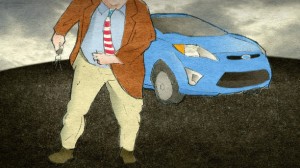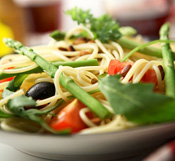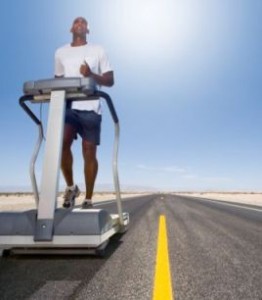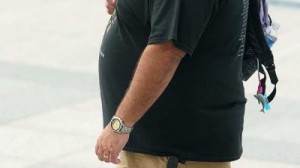
Analysts say Americans' waistlines may keep us from choosing small cars. (Adam Morath, AOL Autos)
Karen Steelman, a stay-at-home mom from Athens, Ga., has tried to like small cars. She read plenty of reviews, kicked their tires, and has even taken a few test drives.
But none of them make her feel safe. And none of them make her feel comfortable.
Steelman has a body mass index of about 37 – seven points above the obesity mark. She’s among a growing number of Americans who feel they are too big to comfortably drive a small car.
“I want to be environmentally friendly, but unless I am in an SUV these days … I find no pleasure or comfort in driving,” she says.
Automakers have long tried to figure out how to get Americans to buy smaller cars. But with obesity rates climbing, at least one analyst says there’s little point in trying.
Growing waistlines simply prevent a lot of U.S. drivers from feeling comfortable or secure in smaller cars. So, unless the entire country goes on a diet, says Dan Cheng, vice president and partner at business consulting firm AT Kearney, we may be destined to keep driving big cars no matter how much a gallon of gas costs in the future.
Cheng says the number of light trucks – a segment of the car market that includes SUVs, minivans, and pickup trucks – has increased steadily since the 1970s. And so has the percentage of adults in the U.S. who are classified as obese.
The number of obese people in the U.S. is expected to increase from 40% this year to about 43% in 2018, Cheng says. Cheng predicts that will keep almost half the population from even considering a small car except for purely economic reasons as small cars tend also to be cheaper than big cars or SUVs.
Calculating the “real” obesity rate in the U.S. is a little tricky. Cheng’s 40% rate is at the high end of estimates. The Center for Disease Control says the overall self-reported obesity rate in the U.S. is 26.7%, with nine states reporting obesity rates over 30%. In any case, the rate is nowhere close to the 15% rate the CDC considers to be a healthy obesity rate.
Small cars have made up 22.6% of the U.S. car market so far this year. Back in 2008, small car sales made up about 28% of the market, back when gas spiked over $4 a gallon.
Smaller cars and alternative fuels are critical to President Obama’s plan to reduce the nation’s dependence on foreign oil. The President last week promised to cut oil imports by a third by 2025. To do that, the country will have to slash its petroleum use.
First Lady Michelle Obama has made fighting childhood obesity one of her public service missions, but so far no one in the Obama Administration has made the connection.
Virtually All Cars and SUVs are Becoming Much More Fuel Efficient
Today’s SUVs and mid-sized sedans and crossovers are becoming more fuel efficient than their predecessors of a decade ago. But it’s smaller cars, which tend to be the most fuel efficient of all because they are smaller and lighter, that are critical to automakers meeting toughening fuel economy standards imposed by Congress.
Automakers have to meet a Congressionally mandated fleet average of 35 mpg by 2016.
Some of the most fuel-efficient small vehicles on the road get over 40 mpg, like the Ford Fiesta. The most fuel-efficient pickup truck is the Ford Ranger, and it gets 24 mpg, according to the government site fueleconomy.gov. A new Kia Rio, debuting this fall, will also be above 40 mpg when certified by the EPA. But neither of these vehicles was especially designed to accommodate widening waistlines.
Ironically, there are a few small cars that are designed to be extra roomy inside making them noteworthy for their interior spaciousness, if not for exceptional fuel economy. The Honda Fit, Nissan Cube and Versa, and Scion xBall have ample space up front, with good headroom and comfortable space for the driver. The Volkswagen Beetlehas long been a favorite among large people because of its easy egress and excess headroom.
Of those cars, only the Fit and Versa get above 30 mpg, and only just barely. In order for automakers to reach a 35 mpg fleet average by 2016, automakers need to boost those ratings closer to 40 mpg.
The most fuel efficient compact SUVs — the Hybrid versions Ford Escape, Mercury Mariner and Mazda Tribute — get 32 mpg. Their non-hybrid versions get 25 mpg.
Resources For the Future, a Washington D.C. think-tank that explores environmental and energy issues, says they’ve found a link between obesity and large vehicle sales, too. They say policies that reduce obesity can also reduce fuel consumption, because smaller people drive smaller cars.
Automakers like Ford are trying to design interiors that keep the bigger population comfortable. Elizabeth Baron, Ford’s technical specialist for virtual reality and advanced visualization, says the automaker has recently updated its database of model human sizes to incorporate the growing number of obese adults.
Automakers Looking at Console and Roofline To Make More Room
To keep drivers comfortable, her team focuses on a few key areas: The center console, seat controls on the left, and head room. If the center console is too large, it can press into peoples’ bodies. And the storage space in the console can be awkward for larger people to use. Seat controls can also be difficult to reach. Also, because obese drivers sit higher in their seats, they often feel squeezed if the roof line is too low. Automakers also need to be aware of where they place sunroof controls, because those can get in the way.
Robert Dean Cole, from Kenosha, Wis., is 6 foot 7 inches and 240 pounds, and his six-year-old son is nearly 5 feet tall.
“Obviously, little cars are not going to be in our future,” he says.
While he’d like to own a car with better gas mileage, he says he can barely fit behind the steering wheel in most of them.
“And even if I could actually fit under the steering wheel of the car my next worry would be surviving a car accident,” he says. “Good chance I won’t be surviving due to my size.”
So he recently purchased a Ford F-150 – one of the biggest vehicles in the U.S. It is also the most popular.
Jake Fisher, senior engineer at Consumer Reports, thinks it’s more that fear of being crushed that keeps most people away from small cars. Fisher has recently been test-driving a Fiat 500 for Consumer Reports, and he can fit his entire family in the car comfortably. They’ve enjoyed using it for around town.
But out on the highway, when they encounter some trucks, being in the small can feel a bit sketchy, he says. “When you drive up next to a Suburban, it’s a little intimidating,” Fisher says.
Consumer Reports, in fact, last year came out with a list of “Best Cars for Larger Drivers,” to spotlight their recommendation to auto companies to redesign seats and seat-belts for reasons of both comfort and safety. The consumer advocacy organization, which tests cars, recommended several cars for their roomy driver position and easy access. AOL Autos Editors augmented that list with a few selections and can be seen in the gallery below.
Still, because SUVs have been so popular for so long, many consumers won’t consider small cars out of fear they will come up on the short end of a one-on-one collision with one. Also, auto designers say many drivers, especially women, have come to like the elevated, commanding seating positions that come with SUVs. This attitude is especially prevalent in rural markets where pickups and SUVs make up a larger percentage of overall vehicles than in the cities and suburbs.
But the idea that bigger is safer is often not true. Many small cars get as good or better crash ratings than larger vehicles because automakers have engineered many safety features into small cars precisely to make up for their lack of mass in a collision with a larger vehicle. The 2011 Ford Fiesta has a 4-star crash rating from the Federal government, as listed at www.safecar.gov, the same as the Ford F-150 pickup truck, and better than some larger corossovers and SUVs like the Toyota RAV4 (which gets 3-Star). The Scion TC, built by Toyota and a small car, earned a 5-star rating.
It’s important to research each car under consideration for purchase because size of vehicle doesn’t always tell the whole safety story. But the vehicle does need to fit in the first place when a customer sits behind the wheel.
Bottom Line
A vehicle needs to fit its occupant, and clever design and engineering can overcome size limitations. As any large person who has test driven cars can attest, the Honda Fit and VW Beetle are roomier for the driver than some larger vehicles like Ford Taurus or Nissan Maxima.
Automakers under pressure to achieve better fuel economy across their lineup may need to give greater consideration to making small cars more comfortable for average Americans. Those that place sleek design over practical will lose customers and consideration.















